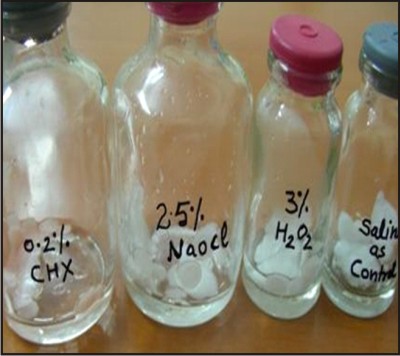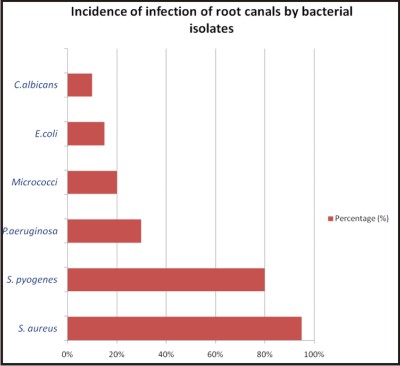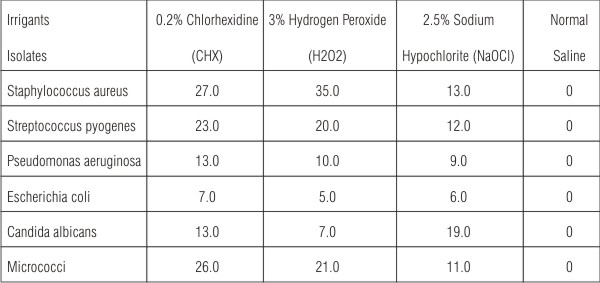Clinical Significance
Clinical significance of this study is estimate antimicrobial efficacy of these root canal irrigants for successful and uneventful root canal treatment.
Introduction
Bacteria and their byproducts are considered as the major etiological factors for endodontic diseases. The various microorganisms isolated from the infected root canals are gram positive and gram negative aerobes, obligatory anaerobes and yeast Abirami CP et.al (1999). There has always been a strong correlation between the basic sciences of microbiology and the clinical science of endodontics. The microbial flora of the root canal system is polymicrobial. Mainly facultative anaerobes and obligatory anaerobes. The success of endodontic treatment is directly influenced by the elimination of microorganisms from infective root canals. Irrigant solutions are essential during root canal preparation because of their help in cleaning the root canal, lubricate the files, flush out debris, kill bacteria, and dissolve tissue without damaging the priapical tissues. The selection of ideal irrigants depends upon its antibacterial action Eracan E et.al (2006) . Therefore this study was conducted to determine the efficacy of the antimicrobial activity of the irrigants, namely sodium hypochlorite, hydrogen peroxide, and chlorhexidine against commonly isolated aerobic and anaerobic organisms from root canal infections.
Materials & Methods
Patients, visiting Department of Conservative dentistry and Peadodontics dentistry during this period, with the proven history of root canals exposure were included in the study.
Criteria for inclusion of the patients:
Patients with following symptoms and criteria were included in this study.
Patients with history of toothache and / or swelling for 2-3 days.
Patients showing clinical signs and symptoms with radiographic evidence of root canal exposure.
Exclusion criteria:
Patients with previous history of root canal treatment were excluded from the study.
Material Used:
A pair of sterile disposable gloves and disposable mouth masks.
Stainless steel kidney tray, mouth mirror, tweezer.
Sterile absorbant paper points.
Culture medium like Nutrient agar, MacConkey agar, Blood agar, Potato dextrose agar and Muller -Hinton agar.
0.2% chlorhexidine (CHX), 2.5% Sod. hypochlorite (NaOCl), 3% hydrogen peroxide (H2O2), sterile physiological normal saline.
Methods
Root canal access opening in the teeth was prepared with the help from endodontologist. After gaining the adequate access to the canal, sterile paper points were placed in the canal for few seconds. After some time paper points were removed with the help of a sterile forceps and inoculated in the nutrient broth. The test tubes incubated at 370 C for 24 hrs. Development of turbidity in the medium indicated growth of microorganisms. The turbid culture suspensions were subcultured on Nutrient agar, MacConkey agar, Blood agar and Potato dextrose agar. Each plate was incubated at 370C for 24-48 hrs and after incubation plates were observed for colonies characteristics.
 | Fig.1 showing whatman filter paper discs impregnated with four irrigants viz: 0.2 % Chlorhexidine (CHX), 3.0 % hydrogen peroxide ( H2O2), 2.5 % sodium hypochlorite ( NaOCl) and normal saline.
 |
 | Fig.2 Showing zone of inhibtion by irrigants on muller-hinton agar
 |
 | Fig.3 showing incidance of infection of root canal bacterial isolates
 |
 | Table: 1 Showing means of diameter (in mm) of inhibition zones by irrigants using agar diffusion test
 |
Results
The most abundant was Staphylococcus aureus which was isolated from all but one patient, thus accounting for 95% of root canal infections. This was followed by Streptococcus pyogenes which was found in 16 samples 80%, Pseudomonas aeruginosa 30% occurrence while Micrococci 20%, Escherichia coli 15% and Candida albican 10% . Only one patient was found to infected with Streptococcus pyogenes alone, all others were multiply infected. Incidence of occurrence (%) of these organisms .
Zone of inhibition: zone of inhibition by different irrigants was compared using impregnated filter paper discs. Staphylococcus aureus showed 27.0 mm zone of inhibition with the 0.2% Chlorhexidine impregnated paper disc. This was followed by zone of inhibition(26.0mm) for Micrococci, (23.0 mm) for Streptococcus pyogenes, (13.0 mm ) for Pseudomonas aeruginosa, (13.0 mm) for Candida and (7.0 mm ) for Escherichia coli .
For 2.5% NaOCl 19.0mm zone of inhibition was observed for Candida albicans followed by (13.0 mm) for Staphylococcus aureus, (11.0 mm) for Micrococci, (12.0 mm) for Streptococcus pyogenes, (9.0 mm) for Pseudomonas aeruginosa and (6.0 mm) for Escherichia coli.
Largest zone of inhibition i.e. 35.0 mm was observed around Staphylococcus aureus when 3% H2O2 was used in paper discs. This was followed by 21.0 mm, 10.0mm, 7.0mm, for Micrococci, Streptococcus pyogenes, Pseudomonas aeruginosa, Candida albicans and Escherichia coli respectively.
For Staphylococcus aureus 35.0 mm zone of inhibition was observed with 3% H2O2 where as 27.0 mm with 0.2% Chlorhexidine and 13.0 mm for 2.5% NaOCl. But widest zone of inhibition for Staphylococcus aureus was observed with 0.2% Chlorhexidine. Similarly 0.2% Chlorhexidine showed widest zone of inhibition for Pseudomonas aeruginosa as well as for Escherichia coli and Micrococci.
Summary & Conclusion
The Success of endodontics treatment is negatively influenced by the presence of microorganisms within the root canal system. The studies have shown the relationship between the development of apical periodontitis and colonization of pulpal space by bacteria. Apical periodontitis is an inflammatory process of the periradicular region and is initiated and sustained by endodontics infection Zerella JA et.al (2006). The control and the elimination of microorganisms are very important during endodontics treatment because of their role in pulpal and perapical diseases. Therefore this study was carried out to find the efficacy of various root canal irrrigants (0.2% CHX, 2.5% NaOCl, 3% H2O2).
Study conducted by Oztan MD et.al (2006). has shown that in primary endodontic infections, micro flora consists mostly of anerobes. However, in case of failed endodontics treatment the intracanal flora is different and facultative anaerobes may predominate. These results are in concordance to our study in which the predominate organisms isolated were facultative anaerobes.
Mechanical instrumentation- associated irrigation has been considered to play a key role to the success of endodontics treatment. Sodium hypochlorite, owing to its powerful germicidal and bactericidal properties is still the most frequently used root canal irrigants Bystorm A & Sundqvist G (1983).
Chlorhexidine gluconate is a cationic biguanide that combines to the cell wall of the bacteria and causes the leakage of intracellular components.At low concentration of CHX small molecular weight substances will leak out resulting in a bacteriostatic effect. At higher concentration CHX has bactericidal effect owing to precipitation and coagulation of cytoplasm, probably caused by protein cross linking Dametto FR et.al (2005).
The antimicrobial activity of sodium hypochlorite depends upon the concentration of undissociated hypochlorous acid in solution. The hypochlorous acid exerts its germicidal effect by an oxidative action on sulfydryl groups of bacterial enzymes as essential enzymes are inhibited, important metabolic reactions are disrupted resulting in the death of bacterial cell Baumgartner JC & Cuenin PR (1992) .
3% H2O2 when used as irrigant, it liberates nascent oxygen which oxidizes necrotic matters and bacteria. Catalysts present in the tissue speeds decomposition resulting in foaming- helps in loosening the debris (Tripathi KD).
In our study 0.2% Chlorhexidine showed better antimicrobial effect against all the organisms tested as compared to the other irrigants used. This is a contradictory to the study conducted by Vianna ME et.al. (2004) in which 5.25 % NaOCl used as irrigant showed the better results as compared to the 0.2% CHX gel. The reason for this contradiction can be due to the higher concentration (5.25 %) of NaOCl used in this study as compared to the 2.5% NaOCl used in our study.
But the results of our study are in concordance with the study conducted by Dametto FR et.al (2005) in which 0.2% CHX gel was proved to be more efficacious root canal irrigant as compared to the NaOCl. So the results of present study indicate that 0.2% Chlorhexidine is very effective antimicrobial endodontics irrigant. These results are almost similar to the study conducted by Abirami and Subba Rao (1999) which has showed that 0.2% chlorhexidine and 3% H2O2 are superior in antimicrobial activity against all the microorganisms.
Discussion
Present study has high lightened the polymicrobial nature of root canal infection and importance of obligate and facultative microorganisms in root canal infection. Furthermore this study has also correlated the effectiveness of various root canal irrigants in endodontology.
Our study has shown the effectiveness of sod. hypochlorite as root canal irrigant against some common root canal pathogens. But overall effectiveness of CHX has proven to be better than NaOCl and H2O2. Large scale studies are required to further refine issues related to the effectiveness of various root canal irrigants in endodontology.
Bibliography
1. Abirami CP, Subba Rao CV (1999). Evaluation of the antimicrobial activities of root canal irrigants: an in vitro study.Endodontology - Journal of Indian Endodontic Society. 2:27-29.
2. Baumgartner JC, Cuenin PR (1992) . Efficacy of several concentrations of sodium hypochlorite for root canal irrigation. J Endod. 18: 605-12.
3. Bystorm A, Sundqvist G (1983). Bacteriological evaluation of the effect of 0.5%sodium hypochlorite in endodontics therapy. Oral Surg Oral Med Oral Pathol Oral RadiolEndod. 55: 307-12.
4. Dametto FR, Ferraz CCR, Gomes BPFDA, Zaia AA. Teixeira FB (2005) . In vitro assessment of the immediate and prolonged antimicrobial action of chlorhexidine gel as an endodontic irrigants against Enterococcus faecalis. Oral Surg Oral Med Oral Pathol Oral Radiol Endod. 99: 768-72.
5. Eracan E, Dulgergil T, Yavuz I (2006) . The effects of antibacterial solution on microorganisms isolated from infected root canals IN VIVO. Biotechnol& Biotechnol.Eq. 20 : 1.
6. Oztan MD, Kiyan M, Gerceker D (2006). Antimicrobial effect, in vitro gutta-percha pointscontaining root canal medications against yeast and Enterococcus faecalis. Oral Surg Oral Med Oral Pathol Oral RadiolEndod. 102(3) : 410-416.
7. Tripathi KD. Essentials of medical pharmacology. Fifth edition. Page 805-806.
8. Vianna ME, Berber VB, Ferraz CCR (2004). In vitro evaluation of the antimicrobial activity of chlorhexidine and sodium hypochlorite. Oral Surg Oral Med Oral Pathol Oral RadiolEndod. 97: 79-84.
9. Zamany A, Larz SW (2003) . The effect of chlorhexidine as an endodontic disinfectant. Oral Surg Oral Med Oral Pathol Oral Radiol Endod . 96: 578-81.
10. Zerella JA, Fouad AF, Larz SW (2005) . Effectiveness of calcium hydroxide and chlorhexidine gluconate mixture as disinfectant during treatment of failed endodontic cases. Oral Surg Oral Med Oral Pathol Oral RadiolEndod. 100 : 756-61. |